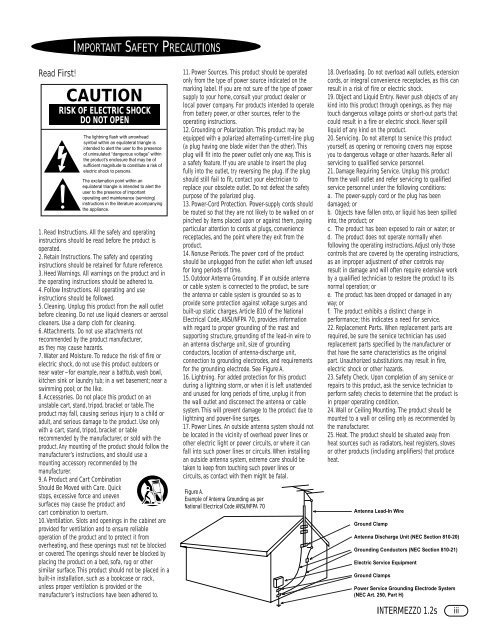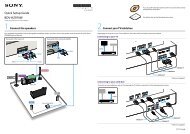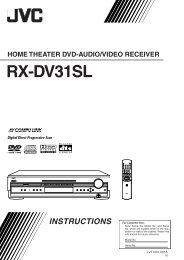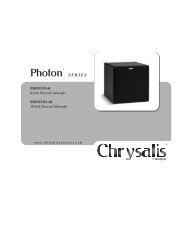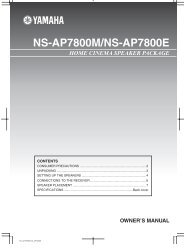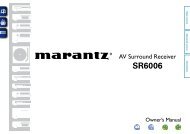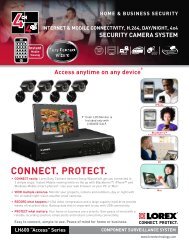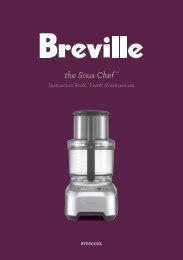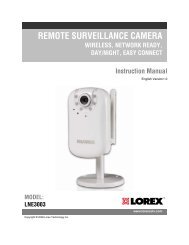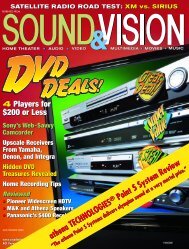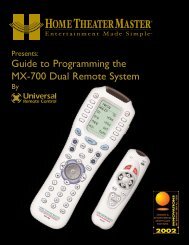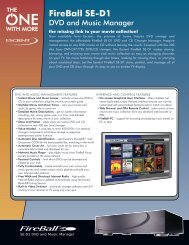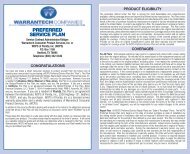Intermezzo 1.2s OM
Intermezzo 1.2s OM
Intermezzo 1.2s OM
Create successful ePaper yourself
Turn your PDF publications into a flip-book with our unique Google optimized e-Paper software.
Read First!<br />
IMPORTANT SAFETY PRECAUTIONS<br />
CAUTION<br />
RISK OF ELECTRIC SHOCK<br />
DO NOT OPEN<br />
The lightning flash with arrowhead<br />
symbol within an equilateral triangle is<br />
intended to alert the user to the presence<br />
of uninsulated “dangerous voltage” within<br />
the product’s enclosure that may be of<br />
sufficient magnitude to constitute a risk of<br />
electric shock to persons.<br />
The exclamation point within an<br />
equilateral triangle is intended to alert the<br />
user to the presence of important<br />
operating and maintenance (servicing)<br />
instructions in the literature accompanying<br />
the appliance.<br />
1. Read Instructions. All the safety and operating<br />
instructions should be read before the product is<br />
operated.<br />
2. Retain Instructions. The safety and operating<br />
instructions should be retained for future reference.<br />
3. Heed Warnings. All warnings on the product and in<br />
the operating instructions should be adhered to.<br />
4. Follow Instructions. All operating and use<br />
instructions should be followed.<br />
5. Cleaning. Unplug this product from the wall outlet<br />
before cleaning. Do not use liquid cleaners or aerosol<br />
cleaners. Use a damp cloth for cleaning.<br />
6. Attachments. Do not use attachments not<br />
recommended by the product manufacturer,<br />
as they may cause hazards.<br />
7. Water and Moisture. To reduce the risk of fire or<br />
electric shock, do not use this product outdoors or<br />
near water–for example, near a bathtub, wash bowl,<br />
kitchen sink or laundry tub; in a wet basement; near a<br />
swimming pool; or the like.<br />
8. Accessories. Do not place this product on an<br />
unstable cart, stand, tripod, bracket or table.The<br />
product may fall, causing serious injury to a child or<br />
adult, and serious damage to the product. Use only<br />
with a cart, stand, tripod, bracket or table<br />
recommended by the manufacturer, or sold with the<br />
product. Any mounting of the product should follow the<br />
manufacturer’s instructions, and should use a<br />
mounting accessory recommended by the<br />
manufacturer.<br />
9. A Product and Cart Combination<br />
Should Be Moved with Care. Quick<br />
stops, excessive force and uneven<br />
surfaces may cause the product and<br />
cart combination to overturn.<br />
10. Ventilation. Slots and openings in the cabinet are<br />
provided for ventilation and to ensure reliable<br />
operation of the product and to protect it from<br />
overheating, and these openings must not be blocked<br />
or covered.The openings should never be blocked by<br />
placing the product on a bed, sofa, rug or other<br />
similar surface.This product should not be placed in a<br />
built-in installation, such as a bookcase or rack,<br />
unless proper ventilation is provided or the<br />
manufacturer’s instructions have been adhered to.<br />
11. Power Sources. This product should be operated<br />
only from the type of power source indicated on the<br />
marking label. If you are not sure of the type of power<br />
supply to your home, consult your product dealer or<br />
local power company. For products intended to operate<br />
from battery power, or other sources, refer to the<br />
operating instructions.<br />
12. Grounding or Polarization. This product may be<br />
equipped with a polarized alternating-current-line plug<br />
(a plug having one blade wider than the other).This<br />
plug will fit into the power outlet only one way.This is<br />
a safety feature. If you are unable to insert the plug<br />
fully into the outlet, try reversing the plug. If the plug<br />
should still fail to fit, contact your electrician to<br />
replace your obsolete outlet. Do not defeat the safety<br />
purpose of the polarized plug.<br />
13. Power-Cord Protection. Power-supply cords should<br />
be routed so that they are not likely to be walked on or<br />
pinched by items placed upon or against them, paying<br />
particular attention to cords at plugs, convenience<br />
receptacles, and the point where they exit from the<br />
product.<br />
14. Nonuse Periods. The power cord of the product<br />
should be unplugged from the outlet when left unused<br />
for long periods of time.<br />
15. Outdoor Antenna Grounding. If an outside antenna<br />
or cable system is connected to the product, be sure<br />
the antenna or cable system is grounded so as to<br />
provide some protection against voltage surges and<br />
built-up static charges. Article 810 of the National<br />
Electrical Code, ANSI/NFPA 70, provides information<br />
with regard to proper grounding of the mast and<br />
supporting structure, grounding of the lead-in wire to<br />
an antenna discharge unit, size of grounding<br />
conductors, location of antenna-discharge unit,<br />
connection to grounding electrodes, and requirements<br />
for the grounding electrode. See Figure A.<br />
16. Lightning. For added protection for this product<br />
during a lightning storm, or when it is left unattended<br />
and unused for long periods of time, unplug it from<br />
the wall outlet and disconnect the antenna or cable<br />
system.This will prevent damage to the product due to<br />
lightning and power-line surges.<br />
17. Power Lines. An outside antenna system should not<br />
be located in the vicinity of overhead power lines or<br />
other electric light or power circuits, or where it can<br />
fall into such power lines or circuits. When installing<br />
an outside antenna system, extreme care should be<br />
taken to keep from touching such power lines or<br />
circuits, as contact with them might be fatal.<br />
Figure A.<br />
Example of Antenna Grounding as per<br />
National Electrical Code ANSI/NFPA 70<br />
18. Overloading. Do not overload wall outlets, extension<br />
cords, or integral convenience receptacles, as this can<br />
result in a risk of fire or electric shock.<br />
19. Object and Liquid Entry. Never push objects of any<br />
kind into this product through openings, as they may<br />
touch dangerous voltage points or short-out parts that<br />
could result in a fire or electric shock. Never spill<br />
liquid of any kind on the product.<br />
20. Servicing. Do not attempt to service this product<br />
yourself, as opening or removing covers may expose<br />
you to dangerous voltage or other hazards. Refer all<br />
servicing to qualified service personnel.<br />
21. Damage Requiring Service. Unplug this product<br />
from the wall outlet and refer servicing to qualified<br />
service personnel under the following conditions:<br />
a. The power-supply cord or the plug has been<br />
damaged; or<br />
b. Objects have fallen onto, or liquid has been spilled<br />
into, the product; or<br />
c. The product has been exposed to rain or water; or<br />
d. The product does not operate normally when<br />
following the operating instructions. Adjust only those<br />
controls that are covered by the operating instructions,<br />
as an improper adjustment of other controls may<br />
result in damage and will often require extensive work<br />
by a qualified technician to restore the product to its<br />
normal operation; or<br />
e. The product has been dropped or damaged in any<br />
way; or<br />
f. The product exhibits a distinct change in<br />
performance; this indicates a need for service.<br />
22. Replacement Parts. When replacement parts are<br />
required, be sure the service technician has used<br />
replacement parts specified by the manufacturer or<br />
that have the same characteristics as the original<br />
part. Unauthorized substitutions may result in fire,<br />
electric shock or other hazards.<br />
23. Safety Check. Upon completion of any service or<br />
repairs to this product, ask the service technician to<br />
perform safety checks to determine that the product is<br />
in proper operating condition.<br />
24. Wall or Ceiling Mounting. The product should be<br />
mounted to a wall or ceiling only as recommended by<br />
the manufacturer.<br />
25. Heat. The product should be situated away from<br />
heat sources such as radiators, heat registers, stoves<br />
or other products (including amplifiers) that produce<br />
heat.<br />
Antenna Lead-In Wire<br />
Ground Clamp<br />
Antenna Discharge Unit (NEC Section 810-20)<br />
Grounding Conductors (NEC Section 810-21)<br />
Electric Service Equipment<br />
Ground Clamps<br />
Power Service Grounding Electrode System<br />
(NEC Art. 250, Part H)<br />
INTERMEZZO <strong>1.2s</strong><br />
iii


